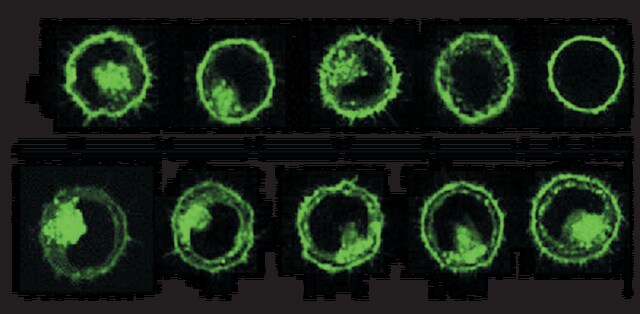MIDI67
PKH67 Green Fluorescent Cell Linker Midi Kit for General Cell Membrane Labeling
Distributed for Phanos Technologies
Sinonimo/i:
Green PKH membrane midi labeling kit
About This Item
Prodotti consigliati
Confezionamento
pkg of 1 kit
Livello qualitativo
Produttore/marchio commerciale
Distributed for Phanos Technologies
Condizioni di stoccaggio
protect from light
tecniche
flow cytometry: suitable
Fluorescenza
λex 490 nm; λem 502 nm (PKH67 dye)
applicazioni
cell analysis
detection
Metodo di rivelazione
fluorometric
Condizioni di spedizione
ambient
Temperatura di conservazione
room temp
Descrizione generale
Slow loss of fluorescence has been observed in in vivo studies using PKH1 and PKH2. PKH67 may exhibit similar properties since this behavior appears to be characteristic of green cell linker dyes, but not red cell linker dyes. Correlation of in vitro cell membrane retention with in vivo fluorescence half life in non-dividing cells predicts an in vivo fluorescence half life of 10-12 days for PKH67. Other green cell linker dyes with similar half lives have been used to monitor in vivo lymphocyte and macrophage trafficking over periods of 1-2 months, suggesting that PKH67 will also be useful for in vivo tracking studies of moderate length.
Applicazioni
- labeling exosomes
- extracellular vesicles (EVs)l
- normal and sickle red blood cells (RBCs)
- Raji cells
Linkage
Note legali
Solo come componenti del kit
- PKH67 Dye 2 x 0.1
- Diluent C 6 x 10
Prodotti correlati
Avvertenze
Danger
Indicazioni di pericolo
Consigli di prudenza
Classi di pericolo
Eye Irrit. 2 - Flam. Liq. 2
Codice della classe di stoccaggio
3 - Flammable liquids
Punto d’infiammabilità (°F)
57.2 °F - closed cup
Punto d’infiammabilità (°C)
14 °C - closed cup
Certificati d'analisi (COA)
Cerca il Certificati d'analisi (COA) digitando il numero di lotto/batch corrispondente. I numeri di lotto o di batch sono stampati sull'etichetta dei prodotti dopo la parola ‘Lotto’ o ‘Batch’.
Possiedi già questo prodotto?
I documenti relativi ai prodotti acquistati recentemente sono disponibili nell’Archivio dei documenti.
I clienti hanno visto anche
Articoli
Optimal staining is a key component for studying tumorigenesis and progression. Learn useful tips and techniques for dye applications, including examples from recent studies.
A video about how you can use fluorescent cell tracking dyes in combination with flow and image cytometry to study interactions and fates of different cell types in vitro and in vivo.
PKH and CellVue® Fluorescent Cell Linker Kits provide fluorescent labeling of live cells over an extended period of time, with no apparent toxic effects.
Il team dei nostri ricercatori vanta grande esperienza in tutte le aree della ricerca quali Life Science, scienza dei materiali, sintesi chimica, cromatografia, discipline analitiche, ecc..
Contatta l'Assistenza Tecnica.














